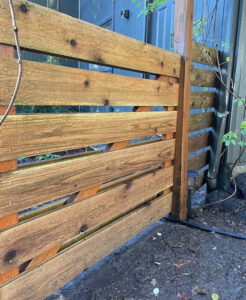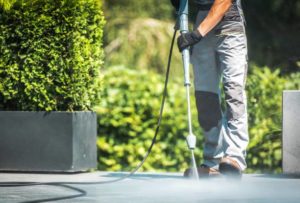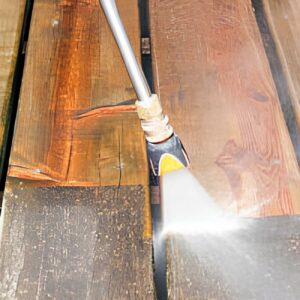Many people try pressure washing but end up making simple mistakes. Did you know using the wrong spray angle can harm your house? This article will show easy ways to avoid common errors in pressure washing.
Keep reading for helpful tips!
Key Takeaways
- Too much pressure can harm surfaces like wood and concrete. It may also remove paint you wanted to keep.
- Choose the right nozzle for the job to avoid damaging surfaces. Wrong nozzles can chip paint or push water into places it shouldn’t be.
- Using wrong detergents can damage surfaces and hurt plants. Always read and follow directions on detergent bottles.
- Wearing safety gear, like goggles and boots, protects against injuries while using a pressure washer.
- Cleaning in the wrong order or not protecting the environment can lead to missed spots or harm nearby plants.
Common Pressure Washing Mistakes to Avoid
Using excessive pressure can lead to surface damage, while using the wrong nozzle can result in ineffective cleaning. Improper use of detergents and neglecting safety equipment are also common mistakes that DIYers should avoid when power washing.
Using Too Much Pressure
Applying excessive force can trigger significant issues. It can possibly fracture wood or exacerbate existing concrete cracks. This intense pressure can also inadvertently eliminate paint, stain, or sealant you wished to keep intact.
Power washers, being potent tools, require thoughtful utilization. If the force employed is overwhelmingly high, it could potentially jeopardize your house’s vinyl siding or eliminate important finishes.
Teams of professional cleaners are well-informed about adjusting their equipment appropriately. They steer clear from causing harm by opting for the appropriate pressure level. For enthusiastic DIYers experimenting with power washing at home, excessively strong pressure is a common oversight.
This error may lead to property damage and even personal injuries, impacting nearby areas as well.
Adequately calibrating the pressure on your washer helps avert accidental damage.
Next, improper selection of a nozzle can introduce further perils in the misuse of these potent cleaning machines.
Incorrect Nozzle Selection
Choosing the right nozzle for a pressure washer is key. Different nozzles make different spray patterns and levels of water power. Using the wrong one can harm surfaces instead of cleaning them.
For example, a powerful nozzle might chip paint off a car or force water under siding, causing damage.
I once used a narrow-angle nozzle to clean my driveway. The high pressure was great for removing dirt, but it also left marks on the concrete. This mistake taught me to match the nozzle with the job at hand.
Spray angles and distances matter too. Shooting water straight up under vinyl siding can push moisture into your house walls. This moisture could lead to mold growth inside your home if not careful.
Always use detergents properly with the correct nozzle for effective and safe cleaning.
Improper Use of Detergents
Using the wrong cleaners can ruin a pressure washing job. Detergents boost cleaning power, but they need careful handling. Pros pick the right wash-up aides and how to apply them. Always follow the directions on detergent bottles.
Using too much or the wrong kind can damage surfaces or harm plants.
To protect landscaping, spray water on plants before starting or cover them with tarps. This helps keep chemicals from hurting your garden while you clean with your pressure washer and degreaser.
Next up is making sure you wear safety gear correctly.
Neglecting Safety Equipment
Protective gear is essential – wearing safety glasses and sturdy boots while pressure washing shields against potential hazards.
Cleaning in the Wrong Sequence
Neglecting Safety Equipment is a significant mistake when pressure washing. This can be followed by Cleaning in the Wrong Sequence, which may lead to inefficient and incomplete cleaning. Here’s how you should go about cleaning in the right sequence:
- Start from the top: Clean the roof, gutters, siding, windows, and finally work your way down to ground installations.
- Pressure washing in the wrong order can result in missed spots and inefficiencies.
- Proper cleaning sequence ensures thorough and effective cleaning while also preventing any potential damage to surfaces.
- Following a systematic approach will help avoid these errors.
Ignoring Environmental Protection
Neglecting environmental protection while pressure washing can result in long-term damage to nearby landscaping. Chemicals used in detergents and cleaners can harm plants, so it’s crucial to take precautions.
Wetting down plants before pressure washing or using tarps to cover them can minimize potential damage. Moreover, certain surfaces like fabric and drywall should not be pressure washed as this could lead to mold risks.
In addition, using hot water during pressure washing can also pose a risk to the environment and surrounding landscape. It has the potential to warp materials that are designed for tap water temperatures, leading to unintended consequences.
Thus, it’s vital to consider these factors and take necessary measures when pressure washing areas near environmentally sensitive zones.
Finally, overlooking environmental protection while pressure washing may result in adverse effects on the ecosystem surrounding the cleaning area. Being mindful of these considerations is essential for maintaining a balance between effective cleaning and safeguarding the environment from unnecessary harm.
Effects of Common Pressure Washing Mistakes
Common mistakes in pressure washing can lead to serious consequences. Surfaces may suffer damage, nearby landscaping could be at risk, and safety hazards might arise.
Damage to Surfaces
Using too much pressure in pressure washing can cause damage to surfaces. This includes splitting wood and worsening cracks in concrete. It may also remove paint, stain, or sealant unintendedly, risking peeling when power-washing painted surfaces.
The use of hot water can even warp residential exteriors.
Pressure washers need to be used with caution as they can lead to unintentional damage if not handled properly. High-pressure water and the incorrect techniques pose a risk of causing harm rather than effective cleaning.
Risk to Nearby Landscaping
Using high-pressure water might appear to be an efficient way to clean surfaces, but it can harm delicate plants and landscaping. Chemicals from detergents used in pressure washing can also cause damage to plants.
To avoid this, wet the nearby plants before cleaning or cover them with tarps. Professional crews are trained to minimize impact on surrounding areas, including protecting landscaping.
Improper use of pressure-washing equipment could result in long-term damage to nearby vegetation and green spaces. High-pressure jets can strip off bark from trees and severely harm delicate shrubs and plants.
Also, chemicals from detergents used in pressure washing run off into the soil, posing risks for plant growth and biodiversity.
Moving forward to “Potential Safety Hazards” section…
Potential Safety Hazards
Using high-pressure washers has its safety concerns. Gas-powered washers operated indoors pose the risk of carbon monoxide exposure, potentially leading to poisoning or even death.
Moreover, excessive pressure can result in injury to the user and others nearby. Protective gear such as goggles and sturdy boots are essential for safeguarding against potential harm during pressure washing activities.
It’s important to note that improper use of pressure washing equipment can lead to water entering properties, causing flooding and mold issues. This not only poses a threat but also leads to extensive damage and costly repairs.
Therefore, it’s always important to prioritize safety measures and strictly adhere to guidelines when utilizing pressure washers.
Conclusion
In summary, the common mistakes in pressure washing can lead to serious consequences. Using excessive pressure can damage surfaces and pose safety risks. Failing to use proper detergent may result in ineffective cleaning and potential harm to nearby landscaping.
Disregarding the correct sequence for cleaning can create extra work. It’s crucial to prioritize safety, use suitable equipment, and follow instructions carefully when pressure washing.
Always ensure to protect surfaces from damage and ensure the job is done safely and effectively.
Experience the Superior Xterior difference! We provide friendly, reliable pressure washing services with a focus on customer satisfaction.
Call us today at (503) 734-9322 for a free estimate and let us take care of your home’s exterior.
Related: 1.) How To Pressure Wash All Of Your Homes Surfaces 2.) Why You Should Use ECO-Friendly Pressure Washing Techniques
FAQs
1. What are some common mistakes in DIY pressure washing?
One of the most common mistakes in DIY pressure washing is not taking proper precautions to protect landscaping and ceramic-lined parts from the high-pressure water spray.
2. How can I avoid damaging my property while using a pressure washer?
You can prevent damage by ensuring that you’re using the correct settings on your pressure washer, protecting delicate areas like ceramic-lined parts, and being aware of your surroundings, especially any nearby landscaping.
3. Is it possible for mildew to grow after improper pressure washing?
Yes, if you don’t properly dry off surfaces or use the right cleaning solutions during your DIY project, it could lead to mildew growth.
4. Can I find tips for effective pressure washing on Internet Explorer?
Certainly! You can use Internet Explorer or any other browser to search for tutorials and guides on how to efficiently operate a pressure washer without making common mistakes.




